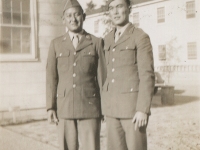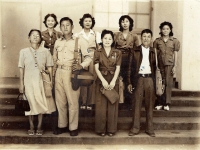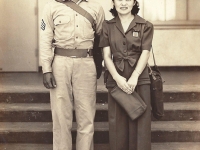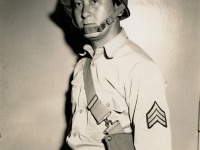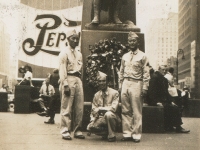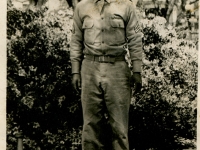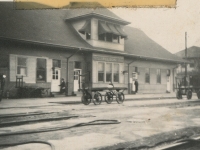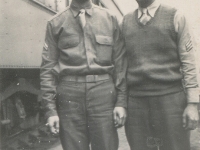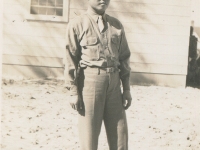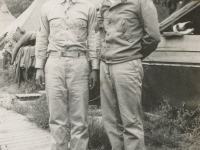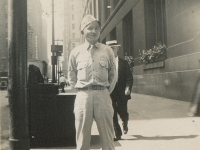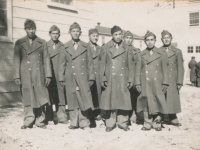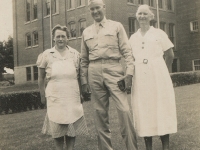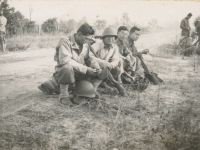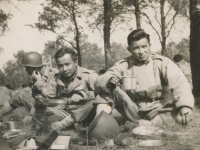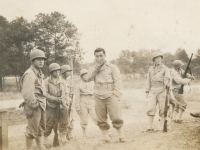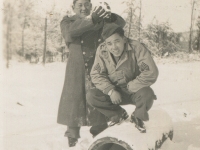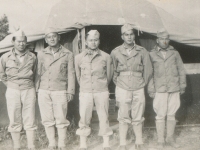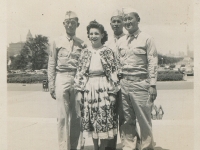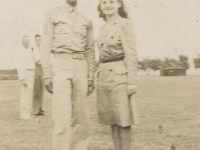Headquarters Company
Calvin Shimogaki was born in 1913 in Honolulu to Kazuichi and Taka Shimogaki, immigrants from Japan. He had an older brother Kazuto who was a photographer during the war for the Honolulu Advertiser and later became the newspaper’s Chief Photographer, plus four younger sisters. His father Kazuichi was a carpenter. Calvin attended McKinley High School and also became a carpenter. He married Ethel Masako Hamada before he left Hawaii with the battalion on June 5, 1942.
Army Service
Before he was inducted into the Army on December 9, 1941, Shimogaki had served in the National Guard for more than seven years. An original member of the 100th Infantry Battalion, he served in the Ammunition and Pioneer platoon and was promoted to the rank of Technical Sergeant. The platoon consisted of a pool of men who were assigned to a variety of manual tasks – often dangerous tasks – including delivering ammunition to units serving in forward positions.
Accounts of Shimogaki’s courage in checking routes for hidden trip wires so his comrades could move through minefields safely appear in several books: “Ambassadors in Arms: Hawaii’s 100th Infantry Battalion” by Thomas Murphy; “Honor By Fire: Japanese Americans at War in Europe and the Pacific” by Lyn Crost; and “Combat Chaplain: The Personal Story of the World War II Chaplain of the Japanese American 100th Infantry Battalion” edited by Monica Yost and Michael Markrich.
In his journals, Chaplain Israel Yost noted that the sergeant was “our expert on mines and demolitions.” After locating a mine, he had to dig it up and defuse it. During the battle at Cassino a bullet disabled his mine detector. Shimogaki crawled in the mud for hours, searching for trip wires with his hands, clearing and marking a path through the minefields. He, along with two other sergeants of the platoon, was awarded a Silver Star for his actions. Chaplain Yost also wrote of enlisting Shimogaki’s services to clear paths when he went to retrieve the corpses of men who had been killed. Shimogaki was awarded a Purple Heart after he was wounded in action in November 1943. He was honorably discharged from the Army in July 1945.
Post War Years
After the war, Shimogaki worked for the Navy at the Public Works Center, Pearl Harbor. After 30 years of service, he retired in 1973 as a Carpenter Supervisor. He and his wife had two children, Alvin and June.
Shimogaki was an active and devoted member of Club 100, the organization 100th veterans formed after they returned to Hawaii. His son Alvin said Club 100 was his father’s life. As a carpenter and overall handyman, he helped with the construction of the clubhouse in Honolulu which was completed in 1952. Alvin remembers his father regularly checking the construction site and later helping to organize the yearly maintenance of the clubhouse. In 1955 Shimogaki was honored as Club 100’s Man of the Year at the 13th annual anniversary banquet attended by 800 members and guests. Among the guests were Hawaii’s governor and mayor, along with the battalion’s original commander, Farrant Turner. He coordinated many of Headquarters Chapter’s Christmas parties and other family nights, often cooking all the food with other veterans. After he retired in 1973, he visited the clubhouse almost daily until his stroke in 1981.
Shimogaki remained close to Chaplain Yost after the war. When the chaplain, his wife and their eleven children lived for four years in Honolulu in the 1960s, Alvin remembers the whole family coming over to their house for lunch.
Calvin Shimogaki passed away in 1984 and was laid to rest at the National Memorial Cemetery of the Pacific (Punchbowl) among his many friends and comrades of the 100th Infantry Battalion.

